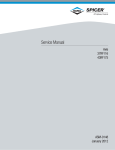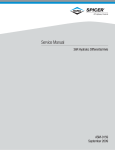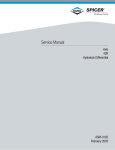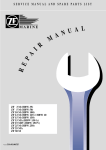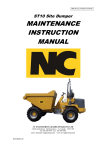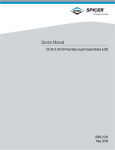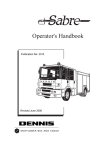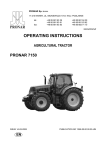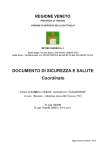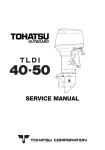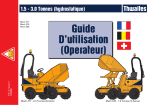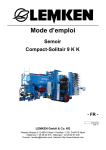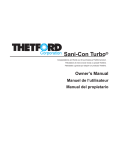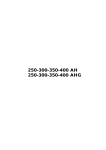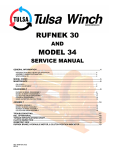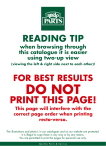Download 37R Hydraloc D&C Service Manual (Final)
Transcript
Service Manual 37R & 43R Hydraloc Differential Supplement ASM-0147 August 2009 37R / 43R Hydraloc Differential Service Manual FOREWORD This manual has been prepared to provide the customer and maintenance personnel with information and instructions on the maintenance and repair of Dana Products. Extreme care has been exercised in the design and selection of materials and manufacturing of these units. The slight outlay in personal attention and cost required to provide regular and proper lubrication, inspection at stated intervals, and such adjustments as may be indicated will be reimbursed many times in low cost operation and trouble free service. In order to become familiar with the various parts of the product, it’s principle of operation, troubleshooting, and adjustments it is urged that mechanics study the instructions in this manual carefully and use it as a reference when performing maintenance and repair operations. Whenever repair or replacement of component parts is required, only Dana approved parts as listed in the applicable parts manual should be used. Use of “will fit” or non-approved parts may endanger proper operation and performance of the equipment. Dana does not warrant repair, replacement parts or failures resulting from the use of parts which are not supplied or approved by Dana. Important: Always furnish serial and model numbers when ordering parts. SAFETY PRECAUTIONS To reduce the chance of personal injury and/or property damaged, the following instructions must be carefully observed. Proper service and repair are important to the safety of the service technician and the safe, reliable operation of the machine. If replacement parts are required the part must be replaced with a Dana specified replacement part. Do not use a replacement part of lesser quality. The service procedures recommended in this manual are effective methods of performing service and repair. Some of these procedures require the use of purpose designed tools. Accordingly, anyone who intends to use a replacement part, service procedure or tool which is not recommended must first determine that neither his safety or the safe operation of the machine will be jeopardized by the replacement part, service procedure or tool selected. It is important to note that this manual contains various “Cautions and Notices” that must be carefully observed in order to reduce the risk of personal injury during service or repair. Improper service or repair may damage the unit or render it unsafe. It is important to understand that these “Cautions and Notices’ are not exhaustive. It is impossible to warn of all possible hazardous consequences that may result from following or failing to follow these instructions. 2 37R / 43R Hydraloc Differential Service Manual TABLE OF CONTENTS 2 3 4 5 6 7 8 10 13 14 15 16 Foreword And Safety Precautions Table of Contents Exploded View and Parts Description Cross Section Hydraloc Differential Pressure Test Instructions Bearing Heating and Freezing Guidelines Cleaning and Inspection Recommended Lubricants Spiral Bevel and Hypoid Tooth Bearing Chart - LH Spiral Bevel and Hypoid Tooth Bearing Chart - RH Fastener Torque Chart Plug and Elastic Stop Nut Torque Charts DISASSEMBLY SECTION 17 Hydraloc Differential Disassembly 17 Drive Flange V-Ring and Wear Sleeve Removal 18 Pinion Seal Retainer Cartridge and Seal Removal 19 Differential Retainer and Adjuster Removal 22 Differential Assembly Removal 22 Ring Gear Removal 23 Differential Body Disassembly 25 Piston Removal 26 Pinion Removal REASSEMBLY SECTION 28 Hydraloc Differential Reassembly 33 Ring Gear Installation 34 Pinion Installation and Adjustment 37 Pinion Seal Installation 39 Wear Sleeve Installation 39 Pinion Flange Installation 40 Carrier Housing Assembly 41 Differential Assembly Installation 42 Differential Retainer Installation 44 Backlash and Contact Pattern Setup and Adjustment 45 Differential Load Test 45 Hydraloc Seal Retainer Assembly and Installation 48 Air Pressure Test 48 Hydraulic Pressure Test SPECIAL TOOL SECTION 49 & 50 Differential Carrier Cup Drivers 51 Grease and Oil Seal Driver 52 Inner Lip Seal Driver 53 Outer Lip Seal Driver 54 Adjusting Nut Driver 55 Hydraloc Sleeve Driver 56 Flange Wear Sleeve Driver 57 Seal Retainer Installation Tool 3 37R / 43R Hydraloc Differential Service Manual EXPLODED VIEW AND PARTS DESCRIPTION Item Qty Description 1 2 3 3A 3B 4 5 6 7 8 9 10 11 12 13 14 15 16 17 18 19 20 1 4 1 1 1 2 1 4 1 2 1 16 16 1 2 1 1 1 1 2 1 1 Screw-Socket Head Capscrew Retainer-Seal Plug-Seal Retainer 6mm Plug-Seal Retainer 3mm Seal-Ring Nut-Differential Brg. Adj. Capscrew Retainer-Differential Plug-Differential Retainer O-Ring Capscrew Washer Seal-Outer Ring-Piston Sleeve-Wear Seal-Inner Cup-Bearing Cone-Bearing Capscrew Case-Diff Flange Half Seal-Inner Piston Item Qty Description 21 22 23 24 25 26 27 28 29 30 31 32 33 34 35 36 37 38 39 40 41 42 1 1 1 1 6 7 1 1 4 4 1 1 1 12 Seal-Inner Piston Backup Piston Seal-Outer Piston Seal-Outer Piston Backup Plate-Friction Plate-Reaction Washer-Side Gear Thrust Gear-Side Washer-Pinion Gear Thrust Gear-Pinion Gear-Side Spider-Differential Assy-Cap & Clutch Hsng Washer 12 1 1 1 1 1 1 2 Capscrew Cone-Bearing Cup-Bearing Gear-Ring Housing-Carrier Nut-Differential Brg. Adj. Lock-Differential Adj. Nut. Capscrew 4 Item Qty Description 43 44 45 46 47 48 49 50 51 52 53 54 55 56 57 58 59 60 61 62 63 2 2 1 1 1 AR 1 1 1 Plug-Magnetic O-Ring-Plug Gear-Pinion Cone-Pinion Inner Bearing Cup-Pinion Inner Bearing Shim-Pinion Bearing Cup-Pinion Outer Bearing Cone-Pinion Outer Bearing O-Ring 1 1 1 Fitting-Grease Cartridge-Seal Retainer Seal-Pinion 1 1 1 1 1 1 1 1 1 Seal-Grease Washer-Thrust Seal-V Ring Sleeve-Wear Flange O-Ring Seal-Spacer Spacer-Pinion Nut-Pinion 37R / 43R Hydraloc Differential Service Manual CROSS SECTION 5 37R / 43R Hydraloc Differential Service Manual HYDRALOC DIFFERENTIAL PRESSURE TEST INSTRUCTIONS 1. Air Pressure Test Air pressure test the pressure and tank port seals and system (Ports "P" & "T") : Apply 83 kpa [12 psi] to pressure and tank ports simultaneously and allow stabilization period of 20 seconds minimum. Lock off pressure and measure decay in 10 seconds. Maximum allowable decay is 23 pa [.0033 psi] in 10 seconds. Alternate decay / period is .69 kpa [.1psi] per 5 minutes. 2. Hydraulic Pressure Test Hydralic pressure test the pressure port seals and system (Port "P") : Apply 4137 kpa [600 psi] to pressure port, with open tank line back to tank. Allow stabilization period of 20 seconds minimum and release. Reapply 4137 kpa [600 psi] and monitor fluid for a (1) one minute period. Fluid flow rate should not exceed 2.83 lpm [.75 gpm] 6 37R / 43R Hydraloc Differential Service Manual BEARING HEATING AND FREEZING GUIDELINES Bearings often must be cooled or heated to aid in assembly or removal. Since temperature extremes can cause permanent bearing metallurgical damage, it is important to take proper precautions and use correct methods when heating and cooling bearings. Cups that are to be assembled in hubs or housings with a press fit may be shrunk in a deep freeze unit. Standard class bearings should not be cooled below -65° F (-54° C). In addition to cooling the bearing cup, in some instances it may be necessary to heat the housing. To control temperature, is best to use a thermostat along with a freezer unit or a properly calibrated thermometer. If a suitable freezer or thermometer is not available, your Timken service representative can suggest liquid combinations that freeze the bearing cup at the optimal temperatures. Regardless of the method, check the cup’s final seating against the housing shoulder with feeler gauges. Take extreme care that standard product bearings are never heated above 149° C [300° F]. If bearings are heated above this temperature, their metallurgical structure may soften, rendering them unsuitable for use. There are a number of recommended methods for heating bearings. Electric ovens or electrically heated oil baths may be used, but only when accompanied by proper thermostatic control. If you use a hot plate to heat the oil, never rest bearings directly on the bottom of the pan. Instead, protect bearings from the heat source with a simple wire screen holder or similar device. Use heat-resistant gloves to handle heated cones. Hold the hot cone solid against the cold shoulder on the shaft until the cone grabs on to the shaft. The hot cone will pull away from the cold shoulder unless it is held in position. Use .002 [.05 mm] feeler gages to make sure the cone is fully seated against the shoulder after the parts are cooled. Many loose bearing settings (excessive end play) are caused by an unseated cone working back against the shoulder in service. 7 37R / 43R Hydraloc Differential Service Manual CLEANING AND INSPECTION CLEANING Clean all parts thoroughly using solvent type cleaning fluid. It is recommended that parts be immersed in cleaning fluid and agitated slowly until parts are thoroughly cleaned of all old lubricants and foreign materials. CAUTION: Care should be exercised to avoid skin rashes, fire hazards and inhalation of vapors when using solvent type cleaners. BEARINGS Remove bearings from cleaning fluid and strike larger side of cone flat against a block of wood to dislodge solidified particles of lubricant. Immerse again in cleaning fluid to flush out particles. Repeat above operation until bearings are thoroughly clean. Dry bearings using moisture free compressed air. Be careful to direct air stream across bearings to avoid spinning. Bearings may be rotated slowly by hand to facilitate the drying process. HOUSINGS, COVERS AND CAPS Clean interior and exterior of housings, bearing caps, etc., thoroughly. Cast parts may be cleaned in hot solution tanks with mild alkali solutions, providing these parts do not have ground or polished surfaces. Parts should remain in solution long enough to be thoroughly cleaned and heated. This will aid the evaporation of the cleaning solution and rinse water. Parts cleaned in solution tanks must be thoroughly rinsed with clean water to remove all traces of alkali. Cast parts may also be cleaned with steam cleaner. CAUTION: Care should be exercised to avoid skin rashes and inhalation of vapors when using alkali cleaners. Thoroughly dry all parts cleaned immediately by using moisture-free compressed air or soft lintless absorbent wiping rags free of abrasive materials such as metal filings, contaminated oil or lapping compound. INSPECTION The importance of careful and thorough inspection of all parts cannot be overstressed. Replacement of all parts showing indication of wear or stress will eliminate costly and avoidable failures at a later date. BEARINGS Carefully inspect all rollers, cages and cups for wear, chipping or nicks to determine fitness of bearings for further use. Do not replace a bearing without replacing the mating cup or cone at the same time. After inspection, dip bearings in clean light oil and wrap in clean lint free cloth or paper to protect them until installed. OIL SEALS, GASKETS AND RETAINING RINGS Replacement of spring loaded oil seals, gaskets, and snap rings is more economical when unit is disassembled than to risk premature overhaul to replace these parts at a future time. Loss of lubricant through a worn seal may result in failure of other more expensive parts of the assembly. Sealing member should be handled carefully, particularly when being installed. Cutting, scratching or curling under lip of seal seriously impairs its efficiency. At reassembly, lubricate lips of oil seals with Multipurpose Lithium grease “Grade 2”. 8 37R / 43R Hydraloc Differential Service Manual CLEANING AND INSPECTION - CONT. GEARS AND SHAFTS If Magna-Flux or a dye penetrant process is available use process to check parts. Examine teeth and the ground/polished surfaces of all gears and shafts carefully for wear, pitting, chipping, nicks, cracks, or scoring. If gear teeth are cracked or show spots where case hardening is worn through, replace with new gear. Small nicks may be removed with suitable hone stone. Inspect shafts to make certain they are not sprung, bent or have twisted splines. HOUSINGS, COVERS AND CAPS Inspect housings and covers to be certain they are thoroughly cleaned and that mating surfaces, bearing bores, etc. are free from nicks or burrs. Check all parts carefully for evidence of cracks or conditions which can cause oil leaks or failures. 9 37R / 43R Hydraloc Differential Service Manual RECOMMENDED RECOMMENDED LUBRICANTS LUBRICANTS FOR FOR DANA DRIVE DRIVE AXLESAXLES Recommendations: Extreme pressure gear lubricant is recommended for use in all drive-steer and rigid drive axles except where explicitly stated differently by Dana Off-Highway Products Engineering. Mineral Based: Acceptable lubricants must meet API GL-5/MT or MIL-PRF2105E qualifications. The highest viscosity grade must be used given the prevailing ambient temperatures from the chart below. Limited slip designated GL-5 oil brands are preferred for quiet operating characteristics. Universal Tractor Transmission Oils (UTTO Fluids): Acceptable lubricants must meet Dana MS266 or J. Deere J20C specifications. Use the highest viscosity grade for the ambient temperatures from the temperature chart below. Synthetics: Synthetic lubricants are recommended providing they meet API GL-5/MT-1 qualifications. The highest viscosity grade must be used given the prevailing ambient temperatures from the chart below. In general synthetic oils have a lower pressure viscosity response than mineral oil lubricants as the contact pressure between the gears increases. This produces a thickening of the mineral oil at the contact point. This increase in viscosity helps to maintain lubricant film thickness reducing the possibility of surface and spalling fatigue. Synthetic lubricants do not thicken as much under pressure unless specifically formulated to do so. Before using a synthetic lubricant in heavy applications, the customer must check with the lubricant supplier on the issue of high-pressure lubricant applications. Normal Oil Change Intervals: Oil change intervals for mineral based lubricants in normal environmental and duty cycle conditions is 1000 hours in all off-highway applications and 10,000 miles in on-highway applications. Severe or sustained high operating temperature or very dusty atmospheric conditions will result in accelerated deterioration or contamination. Judgement must be used to determine the required change intervals for extreme conditions. Extended Oil Change Interval: Extended oil service may result when using synthetic lubricants. Appropriate change intervals must be determined for each application by measuring oxidation and wear metals over time to determine a base line. Wear metal analysis can provide useful information, but an axle should not be removed from service based solely on this analysis. Vehicles, which are prone to high levels of ingested water in the axle, or water as a result of condensation, should not use extended drain intervals. Friction Modifiers: Friction modifiers may be used with the lubricant to reduce Posi-Torq (limited slip) differential noise or liquid cooled brake noise. If friction modifiers are used, follow instructions on TSB 278E. The use of aftermarket lubricant additives other than those specified is not recommended and may reduce the life of the axle and void the warranty! Viscosity Based on Prevailing Ambient Temperature UTTO – SAE 15-30 UTTO – SAE 30 SAE 90 80W90 75W90 75W -40 -40 -30 -22 -20 -4 -10 14 0 32 10 50 10 20 68 30 86 40 104 50 122 37R / 43R Hydraloc Differential Service Manual UNIVERSAL TRACTOR TRANSAXLE OILS (UTTO) RECOMMENDED FOR DANA DRIVE AXLES Viscosity Class: SAE 30 / SAE 20-30 / SAE 15-30 Weights MANUFACTURER AMOCO AQUIP Aral Lubricants GMBH, Bochum/D Avia Mineralol-AG, Munchen/D BP BP Australia LTD, Silverwaters/AUS BP Oil International, London/GB BP Oil International, London/GB Caltrex Petroleum Corp., London/GB Case New Holland Castrol International, Swindon/GB Cheveron Dea Mineralol AG, Hamburg/D ESSO Lubricants Europe, Brussel/B Ford Fuchs Dea Schnierstoffe, Mannhein/D Imperial Oil, Toronto/CDN John Deere, Waterloo/USA John Deere Waterloo/USA Kuwait Petroleum, Europoor/NL Mobil Oil Company LTD, Coryton/GB Mobil Oil Do Brasil, Sao Paulo/BR Mobil Pakelo Motor Oil, San Bonifacio/I Panolin AG, Madetswil/CH Schwechat/A Shell Aseol AG, Bern/CH Shell International, London/GB Shell Texaco Belgium N.V., Brussels/B Texaco Total Fina TRADE NAME AMOCO1000 AQUIP Supertractor Aral Fluid HGS Avia N56 BP Eldoran UTH Tractran TF-10 Tractran TF-9 Terrac Fluid 9 Caltex Textran TDH Premium Hytrans Castrol AGRI Powertrans Chevron THF Deagear TDH OMV AG ESSO Torque Fluid 56 Ford 134D UTF Titan Hydra J20C Torque Fluid N56 Deere Hydgard J20-C John Deere Hy-Gard (Europa) Q8 T 2000 Mobilfluid 424 Mobilfluid 424 Mobil 424 UTF Pakelo UTTO Fluid 4D Panolin JD 303 OMV Austromatic IGB Aseol Multitrac 85W Shell Donax TD 80W Shell Donax TD Textran TDH Premium Texaco TDH Trac Elf C4-1000 NOTES: 1) The above list of oils is not meant to be an all inclusive list of acceptable oils for use in Dana products. 2) It is the end users responsibility to select the best grades of oils available in the local area that provide proper viscosity and limited slip friction additives for long product life and noise free operation. 11 Viscosity Class: SAE 75W-90 / 80W-90 / 85W-90 / 90 12 MANUFACTURER TRADE NAME Addinol Mineralol GMBH, Krump/A/D Addinol Getriebeol 85W90 LS Agip Petroli Spa, Rom/l Agip Rotra, MP/S Aral Lubricants GMBH, Bochum/D Aral Degol 3216 Avia Mineraloi-AG, Munchen/D Avia Hypoid 90 LS Baywa AG, Munchen/D Baywa Getriebeol Hypoid LS 90 Blaser Swisslube, Hasie-Ruegsau/CH Hypoid-Getriebeol LS BP Oil International, London/GB Frontal Getriebeol LS BP Oil International, London/GB Energear Limslip 90 Bucher AG, Langenthal/CH Motorex Gear Oil LS Calpam GMBH, Aschaffenburg/D Calpam Gear Oil LS 90 Castrol International Swindon/GB Castrol Hypoy LS Castrol International Swindon/GB Castrol LSX Citgo USA Citgo Premium LS 80W-90 Citgo USA Citgo Synthetic 75W-90 ELF Lubricants, Paris/F Antar BLS ELF Lubricants, Paris/F HRD EP GL ELF Lubricants, Paris/F Tranself Typ BLS ELF Lubricants, North America Gear Elf BlS90 Eller-Montan-Comp-Duisburg/D Elimo-Hypoid LS ESSO Lubricants Europe, Brussel/B Esso Getriebeoel LSA 85W90 ESSO Imperial Oil NA Esso GX LS 80W-90 ESSO Imperial Oil NA Esso Extra LS 75W-90 Fina Europe, SA Brussel/B Fina Pontonic LS Fina Europe, SA Brussel/B Fina Dynatrans LS Fuchs Dea Schmierstoffe, Mannheim/D Dealear LS Fuchs Dea Schmierstoffe, Mannheim/D Titan Gear LS90 Fuchs Dea Schmierstoffe, Mannheim/D Dealear AWB Furukawa Co LTD, Japan Kyoseki FK Axle 80W90 Genol GMBH, Wiena/A Genol Hypolube LS 90 Ginouves Georges SA, LA Farieda/F York 798 LS HAFA, Paris/F Hypoid PA Igol France, Paris/F Igol Hypoid BPA Indian Oil Corp, Faridabad/Ind Servp Gear Super LS 90 TRADE NAME MANUFACTURER Italiana Petroli, Genova A/I IP Pontiax LS Kompressol-OEL, Koin/D Kompressol-Hypoid EW Leprince + Siveke GMBH, Herford/D Leprinxol LS Liqui Moly GMBH, ULM/D LM Hypoidgetriebeol GL Meguin GMBH, Saariouis/D Megol Hypoidgetriebeol MIN.OL-Raffin Dollbergen, Uetza/D Pennasol Sperrdiff-Getr Mobil Oil, Wedel/D Mobilube LS Mobil USA Mobilube HD 80W-90 LS Mol Hungarian Oil, Komarom/H Carrier Hykomol LS Motul AS, Valres Sur Marne/F Motul 90 PA Nova Stilmoll SPA, Modena/I Gearing Wonder LS 85W Nova Stilmoll SPA, Modena/I Gear G3 Lube Special L Oest G. Min.Ol-Werk, Freudenstadt/D Getriebeol Hypoid LS 90 OMV AG. Schwechat/A OMV Gear Oil LS Orfy International, Vieux-Thann/F Orfy Tucana LS Pakelo Motor Oil, San Bonifacio/I Pakelo Universal Gear E Panolin AG, Madetswil/CH Panolin Super Duty LS Pennzoil NA 4096 80W-90LS Quaker State NA HP 80W-90 Raiffeisen HG Nord AG, Hannover/D HG Getriebeol LS 90 Repsol Distribucion SA, Madrid/E S EP Autoblocante SAEL Madrid/E Gulf LS Rear Axle Oil Schmierstoffraffinerie Saizbergen/D Wintershall Wiolin RSH Shell Aseol AG, Bern/CH Aseol Topress LS Shell International London/GB Shell Getriebeol 90 LS SK Corporation, Eeoul/Korea SK G-LS 80W/90 Gear O Texaco Belgium N.V. Brussels/B Geartex LS Texaco USA Mutligear EP 80W-90 Total Raffinage Distr. Paris/F Total Transmission DA Turbotank Bosche+Bodeker, Bremen/D Turbo Getriebeol LS Unil Deutschland GMBH, Bremen/D Unil Gear AB EP Unil Opal, Rueil Maimaison/F Unil Opal Gear AB-EP Veedol International, Swindon/GB Veedol Multigear L Yacco SA, St Pierre-LES-Elbeuf/F Yahypo BN 90 NOTES: 1) The above list of oils is not meant to be an all inclusive list of acceptable oils for use in Dana products. 2) It is the end users responsibility to select the best grades of oils available in the local area that provide proper viscosity and limited slip friction additives for long product life and noise free operation. 3) Intermixing of GL5 oils with UTTO GL4 oils is not recommended as they are not compatible. 37R / 43R Hydraloc Differential Service Manual API GL5 CLASS GEAR LUBRICANTS WITH LIMITED SLIP ADDITIVES RECOMMENDED FOR DANA DRIVE AXLES 37R / 43R Hydraloc Differential Service Manual LEFT LEFTHAND HANDSPIRAL SPIRAL SPIRAL BEVEL AND HYPOID TOOTH BEARING CHART SPIRAL BEVEL AND HYPOID TOOTH BEARING CHART 13 37R / 43R Hydraloc Differential Service Manual RIGHT HAND HAND SPIRAL SPIRAL RIGHT SPIRAL BEVEL AND HYPOID TOOTH BEARING CHART SPIRAL BEVEL AND HYPOID TOOTH BEARING CHART 14 37R / 43R Hydraloc Differential Service Manual FASTENER TORQUE CHART Size 1/4-20 1/4-28 5/16-18 5/16-24 3/8-16 3/8-24 7/16-14 7/16-20 1/2-13 1/2-20 9/16-12 9/16-18 5/8-11 5/8-18 3/4-10 3/4-16 STANDARD FASTENERS Lubricated and Plated Bolts, CapScrews, and Studs Grade 5 Grade 8 3 Radial Dashes On Bolt Head 6 Radial Dashes On Bolt Head LBF/FT LBF/FT [Nm] [Nm] 10 11 14 15 11 13 15 18 16 30 22 41 20 32 27 43 25 36 34 49 29 41 39 56 41 57 56 77 45 64 61 87 63 88 85 119 99 70 95 134 127 90 122 172 141 100 136 191 175 124 168 237 141 198 191 268 310 220 298 420 347 245 332 470 METRIC FASTENERS Lubricated and Plated Bolts, CapScrews, and Studs Class 8.8 Class 10.9 Class 12.9 8.8 on Bolt Head Size M4 M5 M6 M8 M10 M12 M14 M16 M18 M20 M22 M24 LBF/FT 2.2 4.4 7.4 18 36 63 100 155 221 313 428 538 [Nm] 3 5.9 10 25 49 85 135 210 300 425 580 730 10.9 on Bolt Head LBF/FT 3.2 6.4 11 26 51 92 147 229 317 450 605 774 15 [Nm] 4.4 8.7 15 36 72 125 200 310 430 610 820 1050 12.9 on Bolt Head LBF/FT 7.4 7.4 13 32 62 107 173 269 369 524 708 900 [Nm] 10 10 18 43 84 145 235 365 500 710 960 1220 37R / 43R Hydraloc Differential Service Manual PLUG & ELASTIC STOP NUT TORQUE CHARTS O-RING PLUGS Size LBF/FT 24K-1 5 24K-2 8 24K-3 10 24K-4 13 24K-5 15 24K-6 25 24K-7 35 24K-8 50 24K-9 60 24K-10 75 24K-11 85 24K-12 85 P/N 5/16-24 3/8-24 7/16-20 1/2-20 9/16-18 3/4-16 7/8-14 1 1/16-12 1 3/16-12 1 5/16-12 1 5/8-12 1 7/8-12 PIPE PLUGS Size (NPTF) LBF/FT 1/16-27 7 1/8-27 10 1/4-18 20 3/8-18 30 1/2-14 35 3/4-14 45 [Nm] 9 14 27 41 47 61 1-11 1/2 55 75 1 1/4-11 1/2 65 88 ELASTIC STOP NUTS Size LBF/FT [Nm] 1-20 200 270 1 1/4-18 250 340 1 1/2-18 350 475 1 3/4-12 450 610 16 [Nm] 7 11 14 18 20 34 47 68 81 102 115 115 37R / 43R Hydraloc Differential Service Manual Hydraloc Differential Disassembly Figure 1 Figure 4 Loosen pinion nut. Figure 2 Position unit on bench, support with blocks as shown. Figure 5 Remove pinion nut. Drive Flange V-Ring and Wear Sleeve Removal Figure 6 Remove pinion spacer, spacer seal ring and o-ring. Figure 3 Heat pinion nut to release thread locking compound. 17 37R / 43R Hydraloc Differential Service Manual Figure 10 Grind the cutting edge of a chisel to a radius as shown. Figure 7 Remove flange. Figure 11 Use rounded tip chisel to expand and remove wear sleeve by striking evenly across the width of the sleeve in the three marked locations. IMPORTANT: Do not cut through wear sleeve as damage to the flange will occur. Figure 8 Remove v-ring seal from flange. Pinion Seal Retainer Cartridge and Seal Removal Figure 9 Mark flange wear sleeve in three equally spaced locations as shown across the full width of sleeve. Figure 12 Install (2) M8 screws and flat washers in puller holes. 18 37R / 43R Hydraloc Differential Service Manual Figure 13 Remove seal retainer cartridge. Figure 16 Remove o-ring. Figure 14 Remove pinion seal from cartridge. Figure 17 Remove grease fitting. Differential Retainer and Adjuster Removal Figure 15 Remove grease seal and thrust washer. Figure 18 Remove differential adjusting nut screw and lock. 19 37R / 43R Hydraloc Differential Service Manual Figure 19 Remove adjusting nut lock screw. Figure 22 Remove (2) seal retainer seal rings. Figure 20 Remove (4) seal retainer screws. Figure 23 Remove seal retainer inner oil seal. Figure 21 Remove seal retainer. Figure 24 Remove seal retainer outer oil seal. 20 37R / 43R Hydraloc Differential Service Manual Figure 25 Remove (4) differential retainer screws. Figure 28 Install (2) M8 eye bolts. Figure 26 Loosen differential adjusting nut. Refer to tool drawing on page 54. Figure 29 Install (2) chain clevises, attach hoist. Figure 27 Remove differential adjusting nut. Figure 30 Remove differential retainer. 21 37R / 43R Hydraloc Differential Service Manual Differential Assembly Removal Figure 34 Attach hoist and remove differential assembly and ring gear. Figure 31 Remove seal rings. Ring Gear Removal Figure 32 Remove (2) ring gear mounting screws and washers 180° from each other. Figure 35 Remove (14) ring gear screws and washers. Figure 36 Position wood blocks or equivalent under ring gear and tap with mallet to remove from differential body. Refer to figure 37 Figure 33 Install (2) M16 eye bolts. 22 37R / 43R Hydraloc Differential Service Manual Figure 40 Remove case flanged half. Figure 37 Wood blocks or equivalent placed under ring gear to prevent ring gear damage. Differential Body Disassembly Figure 41 Remove side gear thrust washer. Figure 38 Mark case as shown in (2) places for proper alignment during reassembly. Figure 42 Remove reaction and friction discs. Figure 39 Remove (2) screws. 23 37R / 43R Hydraloc Differential Service Manual Figure 43 Remove side gear. Figure 46 Remove side gear thrust washer. Figure 44 Remove (12) screws and washers. Figure 47 Remove side gear. Figure 45 Remove differential cap. Figure 48 Remove spider with pinion gears and thrust washers. 24 37R / 43R Hydraloc Differential Service Manual Figure 49 Remove (4) pinion gear thrust washers. Figure 52 Apply heat and remove wear sleeve. Figure 50 Remove (4) pinion gears. Figure 53 Apply heat and remove differential bearing cone. Piston Removal Figure 51 Apply heat and remove differential bearing cone. Refer to bearing heating and freezing guidelines. Figure 54 Position differential flange half on bench as shown. Use compressed air to push piston out of bore. 25 37R / 43R Hydraloc Differential Service Manual Pinion Removal Figure 55 Remove piston. Figure 58 Install pinion nut to protect threads and tap pinion through outer bearing cone. Figure 56 Remove outer piston seal and back up ring. Figure 59 Remove pinion assembly. Remove pinion nut. Figure 60 Remove pinion inner bearing cone. Figure 57 Remove inner piston seal and back up ring. 26 37R / 43R Hydraloc Differential Service Manual Figure 61 Remove pinion outer bearing cone. Figure 64 Remove pinion outer bearing cup. Figure 62 Remove differential bearing adjusting nut and cup. Figure 65 Remove bleeder screw and seat. Figure 63 Remove pinion inner bearing cup and shim. Figure 66 Remove plug and o-ring. 27 37R / 43R Hydraloc Differential Service Manual Hydraloc Differential Reassembly Figure 67 Remove plug and o-ring. Figure 68 Apply thin, continuous coat of Loctite 620 or equivalent to wear sleeve mounting surface. Figure 69 Apply thin, continuous coat of Loctite 620 or equivalent to inside diameter of wear sleeve. Figure 70 Install wear sleeve on flange half. NOTE: End of sleeve should be flush with end of journal. Refer to tool drawing on page 55. 28 37R / 43R Hydraloc Differential Service Manual Figure 71 Use compressed air to blow excess sealant from oil passage. Figure 74 Lubricate spider with axle lubricant and install (4) pinion gears. Figure 72 Clean cured thread locking compound from tapped holes with M14x2 tap. Remove remaining residue from holes. Figure 75 Lubricate and install (4) thrust washers. Figure 73 Heat and install differential bearing cone on cap half. Refer to bearing heating and freezing guidelines. Figure 76 Install assembly in clutch housing. 29 37R / 43R Hydraloc Differential Service Manual Figure 77 Install side gear. Figure 80 Lubricate thrust washer. Figure 78 Lubricate side gear. Figure 81 Install differential cap. NOTE: Align identification marks. Figure 79 Install thrust washer. Figure 82 Install (12) socket head screws and washers. 30 37R / 43R Hydraloc Differential Service Manual Lube Groove Figure 83 Tighten screws in a star pattern to 183-202 Nm [135-149 LBF/FT]. Figure 86 Lubricate both sides of friction disc and install. Alternately install remaining reaction and friction discs. Align lube grooves with each other. Figure 84 Install side gear. Figure 87 Lubricate sun gear. Lube Groove Figure 85 Lubricate both sides of reaction disc and install. Figure 88 Install thrust washer. 31 37R / 43R Hydraloc Differential Service Manual Figure 89 Install piston outer seal back up ring. Figure 92 Install piston inner seal ring. NOTE: Back up ring must be installed prior to seal ring. Figure 90 Install piston outer seal ring. NOTE: Back up ring must be installed prior to seal ring. Figure 93 Lubricate piston seals and bore, position piston in bore. Figure 91 Install piston inner seal back up ring. Figure 94 Carefully tap piston into bore evenly with mallet. 32 37R / 43R Hydraloc Differential Service Manual Ring Gear Installation Figure 95 Install differential flange half. NOTE: Align identification marks as shown. Figure 98 Clean foreign material and/or cured thread locking compound from holes with M16x2 tap. Remove remaining residue from holes. Figure 96 Apply Loctite 262 or equivalent to (2) screws and install. Figure 99 Use hone stone or file to remove nicks or burrs from mounting face. NOTE: Be sure to remove all abrasive residue. Figure 97 Tighten (2) screws to 24-27 Nm [18-20 LBF/FT]. Figure 100 Use hone stone or file to remove nicks or burrs from mounting face. NOTE: Be sure to remove all abrasive residue. 33 37R / 43R Hydraloc Differential Service Manual Pinion Installation and Adjustment Figure 101 Heat ring gear to 93-100°C [200-212°F] and Install. Caution: Use gloves to avoid injury. Figure 104 Locate ring gear mounting distance dimension located in this area and record. Figure 102 Temporarily install (2) ring gear mounting screws 180° apart and tighten to 135 Nm [100 LBF/FT]. Allow assembly to cool before installing additional screws. IMPORTANT: Using a .05 mm [.002”] feeler gauge check several locations around ring gear to be sure there is no gap between the ring gear and differential body mounting faces. NOTE: Assembly is shown with ring gear down for clarity. This procedure should be performed with assembly in same position as shown in figure 101. Figure 105 Number as it appears in figure 104. Figure 106 Locate ring gear mounting distance dimension on ring gear and record. Figure 103 Heat and install differential bearing cone. Refer to bearing heating and freezing guidelines. 34 37R / 43R Hydraloc Differential Service Manual Figure 107 Measure height of pinion inner bearing cup and cone and record. Calculate ring and pinion mounting distance shim as follows: Figure 109 Install pinion outer bearing cup. Step #1 Number from ring gear Bearing height Total 186.106 mm [7.3270”] + 45.974 mm [1.8100”] 232.080 mm [9.1370”] Step #2 Number from housing 232.560 mm [9.1559”] Total from step #1 - 232.080 mm [9.1370”] Shim thickness required .480 mm [ .0189”] Figure 110 Install mounting distance shim as determined in figure 107. Figure 108 Heat and install pinion inner bearing cone. Refer to bearing heating and freezing guidelines. Figure 111 Freeze and install pinion inner bearing cup. 35 37R / 43R Hydraloc Differential Service Manual Figure 112 Check for proper seating of pinion inner and outer bearing cups. Refer to bearing and freezing guidelines. Figure 115 Lubricate pinion outer bearing cone. Figure 113 Lubricate pinion inner bearing cone. Figure 116 Heat and install pinion outer bearing cone. Figure 114 Install pinion. Figure 117 Install flange. 36 37R / 43R Hydraloc Differential Service Manual Pinion rolling resistance recorded in figure 120 should be: 37R - 1.13-3.95 Nm [10-35 LBF/IN]. 43R - 1.13-4.52 Nm [10-40 LBF/IN]. If within specification remove nut, spacer and flange. If not within specification repeat steps in figures 118-120 making appropriate spacer substitution. If rolling resistance is too low reduce spacer thickness. If rolling resistance is too high increase spacer thickness. Figure 118 Install pinion spacer. Figure 121 Pinion Seal Installation Figure 119 Install pinion nut and tighten to 1261-1396 Nm [930-1030 LBF/FT]. Figure 122 Apply thin continuous coat of Loctite 620 or equivalent to pinion seal bore. Figure 120 Check pinion bearing rolling resistance and record. Figure 123 Using appropriate driver, install pinion seal. Refer to tool drawing on page 51. 37 37R / 43R Hydraloc Differential Service Manual Figure 124 Apply thin continuous coat of Loctite 620 or equivalent to grease seal bore. Figure 127 Install grease fitting. Figure 125 Using appropriate driver install grease seal and thrust washer. Refer to tool drawing on page 51. Figure 128 Apply grease to seal retainer bore. Figure 126 Install o-ring. Figure 129 Apply grease to pinion and grease seal lips. 38 37R / 43R Hydraloc Differential Service Manual Wear Sleeve Installation Figure 130 Position seal retainer in bore. Figure 133 Apply continuous coat of Loctite 620 or equivalent to wear sleeve I.D. Figure 131 Index retainer so eye brows align. Figure 134 Using appropriate driver install wear sleeve. Refer to tool drawing on page 56. Pinion Flange Installation Figure 132 Carefully tap retainer with a soft mallet evenly around diameter to install. Figure 135 Install v-ring seal. 39 37R / 43R Hydraloc Differential Service Manual Figure 139 Apply Loctite 262 or equivalent to pinion nut threads. Figure 136 Install input flange. Figure 137 Install o-ring and o-ring spacer. Figure 140 Tighten pinion nut to 1261-1396 Nm [930-1030 LBF/FT]. Refer to Figure 131 for fitting location and apply grease to input seals until it comes out from around the dust lip. NOTE: Seals should be greased at every normal servicing interval. Machines in conditions where the axle routinely becomes submerged should be serviced more often. Carrier Housing Assembly Figure 138 Install pinion spacer identified in figures 118-120. Figure 141 Install differential bearing cup. 40 37R / 43R Hydraloc Differential Service Manual Figure 142 Install differential bearing adjusting nut. Figure 145 Lock or hold pinion shaft from turning. Differential Assembly Installation Figure 146 Remove (1) of (2) ring gear screws and mark head of remaining screw for identification purposes. Figure 143 Paint 5 to 6 ring gear teeth with contact checking compound. Figure 147 Apply Loctite 262 or equivalent to (15) ring gear mounting screws and install with washers. Run down but do not tighten. IMPORTANT: Perform the procedures shown in figures 147-149 in a timely manner before the Loctite begins to cure. Figure 144 Install differential assembly in housing. 41 37R / 43R Hydraloc Differential Service Manual Differential Retainer Installation Figure 148 Remove marked screw, apply Loctite 262 or equivalent and install with washer. Figure 151 Install differential bearing cup. Figure 149 Tighten (16) ring gear mounting screws in a star pattern to 286-316 Nm [211-233 LBF/FT]. Using a brass bar or equivalent sharply shock assembly in several locations around the bolt circle. Immediately retighten all screws in a star pattern to 286-316 Nm [211-233 LBF/FT]. Figure 152 Install differential retainer o-ring and lubricate with grease. Figure 153 Install differential bearing adjusting nut. Figure 150 Release pinion shaft. 42 37R / 43R Hydraloc Differential Service Manual Figure 154 Lubricate differential bearing cone with axle lubricant. Figure 157 Install differential retainer. Figure 155 Install (2) piston rings and coat with grease. Figure 158 Install (4) retainer screws and tighten (4) to 24-27 Nm [18-20 LBF/FT]. Figure 156 Install (2) alignment pins located 180° apart. 43 37R / 43R Hydraloc Differential Service Manual Backlash and Contact Pattern Setup and Adjustment Figure 159 Tighten differential adjusting nuts to a minimum of 41 Nm [30 LBF/FT]. Rotate pinion back and forth while performing this step to assure that detectable backlash exists and ring gear is not being forced into pinion gear. Refer to tool drawing on page 54. Figure 162 Install differential adjusting nut lock. IMPORTANT: Advance adjusting nut if necessary to line up mounting holes. Do Not loosen/back off nut. Figure 163 Apply Loctite 262 or equivalent to (2) nut lock screws and install. Tighten to 24-27 Nm [18-20 LBF/FT]. Figure 160 Set up magnetic base dial indicator as shown to measure ring and pinion back lash. With ring gear being held stationary, rock the pinion flange back and forth gently while watching the reading on dial indicator. Backlash specifications are as follows: 37R 4.100 ratio with DIN 180 Flange .56-.88 mm [.022-.035”] 37R 4.100 ratio with DIN 150 Flange .46-.74 mm [.018-.029”] 43R 4.100 ratio with DIN 180 Flange .53-.89 mm [.021-.035”] 43R 4.364 ratio with 8.5 CTP Flange .48-.79 mm [.019-.031”] 43R 4.556 ratio with 8.5 CTP Flange .53-.89 mm [.021-.035”] 43R 5.429 ratio with DIN 150 Flange .53-.94 mm [.021-.036”] If the readings are out of specification, move the differential adjusting nuts inward or outward together. IMPORTANT: Recheck differential bearing preload after the proper backlash reading is achieved. Refer to Figure 159. NOTE: If checking the backlash with an indicator on the ring gear tooth while holding the pinion the specifications are as follows: 37R .25-.33 mm [.010-.013”] 43R .23-.38 mm [.009-.015”] Figure 161 44 37R / 43R Hydraloc Differential Service Manual Differential Load Test Figure 166 Inspect tooth contact pattern on ring gear. Refer to charts on pages 13 & 14. Figure 164 Install stub shaft. NOTE: The axle shaft and a socket can be used to perform this procedure. Hydraloc Seal Retainer Assembly and Installation Figure 167 Apply continuous coat of Loctite 620 or equivalent to outside diameter of inner Hydraloc seal. Figure 165 Step #1 Hold pinion and rotate side gear five turns in each direction. Differential clutch must turn freely with a maximum torque of 34 Nm [25 LBF/FT]. Step #2 Hold side gear and rotate pinion in both directions to make several passes through the gear contact checking compound on the ring gear. Figure 168 Using appropriate driver install inner Hydraloc seal. NOTE: Seal is installed with sealing lip down or towards center of seal retainer. Refer to tool drawing on page 51. 45 37R / 43R Hydraloc Differential Service Manual Figure 169 Apply continuous coat of Loctite 620 or equivalent to outside diameter of outer Hydraloc seal. Figure 172 Install seal retainer plug. NOTE: Plug end to be flush with mating surface. Figure 170 Using appropriate driver install outer Hydraloc seal. NOTE: Seal is installed with sealing lip down or towards center of seal retainer. Refer to tool drawing on page 53. Figure 173 Coat with grease, to hold in position and install (2) seal rings in seal retainer. Figure 171 Apply Loctite 262 or equivalent to seal retainer plug. Figure 174 Insert seal retainer installation tool. Refer to tool drawing on page 57. 46 37R / 43R Hydraloc Differential Service Manual Figure 175 Coat inner and outer Hydraloc seal lips with grease. Figure 178 Tighten seal retainer screws to 24-27 Nm [18-20 LBF/FT]. Figure 176 Carefully install seal retainer. Figure 179 Apply Loctite 262 or equivalent to differential adjusting nut lock screw. Install adjusting nut lock screw in one of the two holes that allow it to clear the lugs on the adjusting nut. Figure 177 Install (4) seal retainer screws. Figure 180 Tighten adjusting nut lock screw to 48-50 Nm [35-37 LBF/FT]. 47 37R / 43R Hydraloc Differential Service Manual Air Pressure Test Figure 184 Install (2) brake supply port plugs and tighten to 18 Nm [13 LBF/FT]. Figure 181 Air pressure test per procedure on page 6. Hydraulic Pressure Test Figure 182 Hydraulic pressure test per procedure on page 6. Figure 185 Install (2) Hydraloc port plugs and tighten to: Port “T” 20 Nm [15 LBF/FT] Port “P” 18 Nm [13 LBF/FT]. Figure 183 Install (2) bleeder valves and seats. Tighten to 24-27 Nm [18-20 LBF/FT]. Figure 186 Install drain and oil level plugs. Tighten to 18 Nm [13 LBF/FT]. 48 37R / 43R Hydraloc Differential Service Manual DIFFERENTIAL CARRIER CUP DRIVERS 49 37R / 43R Hydraloc Differential Service Manual PINION BEARING CUP DRIVER - HEAVY DUTY BEARING 50 37R / 43R Hydraloc Differential Service Manual GREASE AND OIL SEAL DRIVER 51 37R / 43R Hydraloc Differential Service Manual INNER LIP SEAL DRIVER 52 37R / 43R Hydraloc Differential Service Manual OUTER LIP SEAL DRIVER 53 37R / 43R Hydraloc Differential Service Manual ADJUSTING NUT DRIVER 54 37R / 43R Hydraloc Differential Service Manual HYDRALOC SLEEVE DRIVER 55 37R / 43R Hydraloc Differential Service Manual FLANGE WEAR SLEEVE DRIVER 56 37R / 43R Hydraloc Differential Service Manual SEAL RETAINER INSTALLATION TOOL 57 Copyright 2012 Dana Holding Corporation All content is subject to copyright by Dana and may not be reproduced in whole or in part by any means, electronic or otherwise, without prior written approval. THIS INFORMATION IS NOT INTENDED FOR SALE OR RESALE, AND THIS NOTICE MUST REMAIN ON ALL COPIES. For product inquiries or support, visit www.dana.com or call 419-887-6445 For other service publications, visit www.SpicerParts.com/literature.asp For online service parts ordering, visit www.SpicerParts.com/order.asp


























































